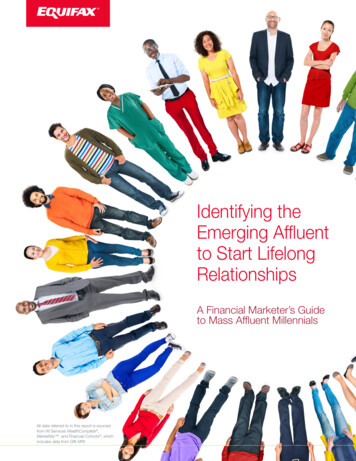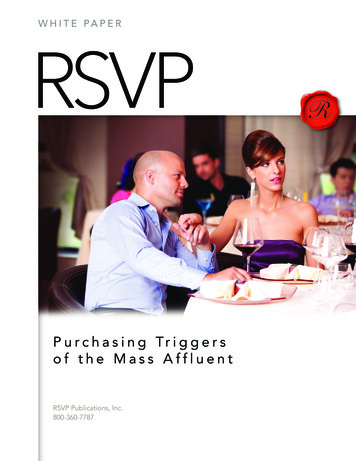
Transcription
Identifying theEmerging Affluentto Start LifelongRelationshipsA Financial Marketer’s Guideto Mass Affluent MillennialsAll data referred to in this report is sourcedfrom IXI Services WealthComplete ,MarketMix , and Financial Cohorts , whichincludes data from GfK MRI.
If you’re marketing to Millennials,you need a new playbookThe emergence of the Millennial generation has many financial institutions eager to form lastingconnections with these younger consumers, who now are entering financial independence.Millennials have just under 1.5 trillion in aggregate investable assets, or a little more than 5% ofthe U.S. total. In relative terms, this is a small portion of the total investable assets, but it representsa group of customers that by virtue of their age will be around for a long time with assets that areexpected to grow.But Millennials look and behave uniquely. They differ dramatically from past generations in theirpreferences, media consumption behaviors, and how they respond to certain types of marketingmessages. Financial marketers cannot simply employ the same playbook that worked for BabyBoomers and Generation X.Here, we’ll take a deep look at the Millennial generation and how its financial profile differs fromprior generations, how different groups of Millennials differ from one another, and then tackle someof the best tactics marketers should employ for reaching this generation.Some Definitions:MillennialsWealth TiersFor the purpose of this report, the term“Millennial” refers to any consumer bornbetween 1980 and 2000. Using this line, thereare approximately 17.6 million householdsheaded by Millennials in the U.S. Becausemany Millennials are not yet heads ofhousehold, but are still part of their broaderfamily units, these numbers likely representlower, more conservative estimates.When discussing wealth tiers, IXI Servicesdivides consumers into three tiers: massmarket, mass affluent, and affluent. Those tiersare defined as follows: Mass Market: Households with less than 100,000 in total investable assets. Mass Affluent: Households with 100,000up to 1 million in investable assets. Affluent: Households with more than 1 million in investable assets.
Investment portfolios of MillennialsMillennials hold only 5.4% of all the financial assets in the U.S.— about 1.5 trillion — and have more money in deposits thanany other generation, at 31%. But drill down to the differentasset tiers, and you’ll find that not all Millennials are the same.Affluent and Mass Affluent Millennials look quite different fromtheir Mass Market Millennial peers, and, in some cases, theirfinancial profile resembles that of Baby Boomers.Banks and financialmarketers targetingMillennials can’t builda strategy around theidea that the entiregeneration is the same.Instead, they need tolook at different tiersand strategize arounddifferent kinds ofconsumers.Affluent Millennials have 21% of their money in deposits, and63% combined in stocks and mutual funds, much like BabyBoomers.Mass Affluent Millennials take on different characteristics,with portfolios that are heavier in mutual funds (37%), but closeto one-third in deposits (32%).And Mass Market Millennials look very different. Nearly 60%of their assets are in deposits, with 34% in stocks and mutualfunds, and just 1% residing in bonds.Mass MarketMass AffluentAffluent 100K 100K - 1M 1M 1%8%8%3%9%7%9%32%19%24%21%59%32%31%37%Average household assets: 15KNumber of U.S. households: 15.5MDepositsSource: IXI Services WealthComplete , 2014Average household assets: 270KNumber of U.S. households: 2MMutual FundsStocksBondsAverage household assets: 3.8MNumber of U.S. households: 188KOther
Looking for emerging affluent Millennials?Focus on the Mass Affluent.Perhaps no segment of the Millennial population is more important to financial marketers than theMass Affluent. This group has started to amass wealth when compared to their Millennial peersin the Mass Market tier. Income, spending, and credit balance are higher for these folks, roughlyon the order of a 2:1 ratio. For the Mass Affluent, the higher levels of spending and credit can besupported by a foundation of assets that is roughly 30 times higher than the Mass Market.These consumers are much more likely to move into the Affluent tier over the course of theirlives than Mass Market consumers, so, it’s within a marketer’s best interest to consider them the“emerging affluent.” Therefore, marketers will likely want to build relationships early, cementinga bond that will last as the Mass Affluent become heads of the household and progress into theAffluent tier.Comparison of Mass Affluent and Mass Market MillennialsEstimated Annual Household EconomicsAssets 269,937 14,697 109,717IncomeDiscretionarySpendingCreditBalance 55,252 76,490 35,586 132,196 65,507Source: IXI Services WealthComplete , Income360 , Discretionary Spending Dollars , and CreditStyles Pro, 2014. Credit Balance includes mortgage.Discretionary Spending reflects the amount the household likely spends on discretionary items after accounting for the fixed expenses of life (housing,utilities, public transportation, personal insuranceand pensions).MassAffluent MillennialsMass Market Millennials
What are they like?When it comes to their professional lives, Mass Affluent Millennials can be described asambitious, with an appetite for advancing in their careers and assuming leadership positions.While the prevailing consensus of the Millennial generation is that many members of thegeneration are slow to start their careers, the Mass Affluent go in the opposite direction, andare keen to begin working toward the future. They have a propensity for jobs that they considercareers, and may view their current industry as one they will remain in for a considerableamount of time. It should come as no surprise that Mass Affluent Millennials are also aneducated group, indexing highly for a bachelor’s or post-graduate degree. And, despite beingrelatively young, they index highly for leadership and supervisory positions.This is a generation that also wants to keep working. Many Mass Affluent Millennials feel theywould continue working even if they won the lottery, and also express a goal to make it to thetop of their profession.Finally, Mass Affluent Millennials are very materially driven, with a belief that material possessionsand wealth are very important to them. This perhaps ties back to their ambition and drive tosucceed in their careers.Mass AffluentMillennials areambitious, withan appetite foradvancing theircareers.
Where do they live?The areas with the highest concentration of Millennials are typically significant metro areas,such as New York, Los Angeles, Chicago, and Washington D.C. When the measure is adjustedto density of Millennials, the top 10 areas change slightly, becoming more heavily associatedwith college towns and university populations such as the University of Iowa, at Ames; PennState; and the University of Illinois at Urbana/Champaign.But if we really dive into the numbers and identify the top 10 metro regions with highestconcentration of Mass Affluent Millennial households compared to the Millennial population,we start to see some trends. It is the usual list of significant metro areas, but the pure collegetowns are gone. The Mass Affluent are concentrated in the tech-heavy areas of California;the advertising/media/finance industries of the greater New York City area, including portionsof lower Connecticut; the science and technology corridors of the Boston area, and thegovernment and policy areas of Washington D.C. In general, Mass Affluent Millennials are in the“right” places to drive the economy and themselves forward.Top 10 Metro Regions with Highest Concentration of Mass Affluent MillennialHouseholds Compared to Millennial PopulationRankMetro RegionConcentrationofMass AffluentMillennials1San Jose-Sunnyvale-Santa Clara, CA32.9% 288,139 122,834 73,0802San Francisco-Oakland-Fremont, CA29.9% 296,420 170,309 89,8433New York-Northern New Jersey-Long Island, NY-NJ-PA25.2% 294,735 127,570 106,7364Boston-Cambridge-Quincy, MA-NH23.2% 282,081 111,780 73,3635Washington-Arlington-Alexandria, DC-VA-MD-WV22.5% 264,915 134,795 104,5266Buffalo-Niagara Falls, NY22.3% 245,890 70,815 41,8027Bridgeport-Stamford-Norwalk, CT22.1% 304,028 113,069 60,0358Santa Cruz-Watsonville, CA22.0% 302,410 119,799 80,6989Trenton-Ewing, NJ21.2% 281,060 112,775 73,05610Napa, CA19.8% 298,817 118,646 80,308Source: IXI Services MarketMix , 2014AssetsAnnualIncomeAnnualDiscretionarySpending
Tips for marketingto Mass Affluent MillennialsMessaging and themesMillennials have entered their careers right after the “greatrecession,” and it seems like every day there is a report aboutthe challenges this generation faces, from low job prospects tohuge student loans that make saving money very difficult. Whilemuch of the press forecasts doom and gloom, many youngerconsumers are taking life by the horns. We know that MassAffluent Millennials are interested in starting careers right now,and that they are also very likely to hold leadership positions, orat least aspire to them. Marketing messages should reflect thisoptimistic outlook whenever possible.Another theme closely tied to this is the idea of financial security.While this generation has lower rates of marriage compared toprior generations, they are expressing positive attitudes andaspirations about being married. In other words, Millennials wantto settle down. Promoting financial security is a great way toearn their trust as they build for the long term.Perhaps as another circumstance of these formative times,Millennials are also a generation that constantly looks foradded value. Financial marketers would do well to promoteand highlight benefits in their campaign messaging, includingrewards programs, points and cash back offers. This kind ofvalue-add is an important element that drives this generation’schoices and behaviors.Finally, marketers need to remember that Millennials are adigital generation. Prior generations still value the personalconnection of going to the bank and talking to a teller. Thisyounger generation is adept at technologies and comfortablebanking online from anywhere – 30% are likely to use a financialor banking application on their phone. They are looking forconvenience, coverage, and the ease of electronic transactions.All marketing aimed at Millennials needs to reflect this mindset.Promotingfinancial securityis a great way toearn their trustas they build forthe long term.
Channels and approachesThis digital inclination goes well beyond ad messaging, of course. Marketers need to take thisalways-online generation’s behavior into account with media planning as well.Millennials are unique in that they move across channels fluently throughout the day. Nearly athird say they are likely to use phone to check websites for financial information, showing thatthis generation sees no distinction between desktop and mobile Internet access. Marketersneed an omni-channel approach if they want to get a Millennial consumer’s attention andremain relevant.Finally, marketers need to remember that they won’t be the only ones delivering a convincingmessage. Millennials are an open generation, one that shares insight and opinion abouteverything from financial products to movies or meals. Friends and family members are hugesources of advice, and Millennials are more likely to trust their friends more than financialadvisers. In fact, a recommendation from a friend is more important to them than an institution’sfinancial security and history. By building easily digestible and shareable facts into ad creative,marketers make it easy for existing customers to share benchmarks and benefits with curiousfriends and peers.Millennials aremore likelyto trust theirfriends morethan financialadvisers.
Start nurturing Millennialrelationships nowFinancial marketers should always look for customers that represent high growth potential, andthere is perhaps no better audience right now than Mass Affluent Millennials. This generation,which is just coming into its own in terms of saving, spending and accumulating wealth, is at thestage where it is looking to build relationships with trusted advisors. These financial relationshipsmay be simple now, but as this generation moves toward affluence, its needs will evolve andbecome more complex. As that happens, there is a strong likelihood that Millennials will turn tothe institutions that they have known and invested with in the past.By using media strategies and creative that meet these emerging affluent consumers wherethey are interacting with media, financial marketers can begin to establish these long-termrelationships today.
Why IXI Services?For over 20 years, IXI Services, a division of Equifax Inc., has helpedthe nation’s leading financial services and consumer marketing firmsoptimize omni-channel marketing efforts, identify growth markets, andenhance practice and performance management. With the help of ourcomprehensive suite of analytical, digital, marketing, software, and datasolutions, marketers can build more profitable business relationshipwith consumers.Our specialty in anonymous, direct-measured data differentiatesour ability to better connect our clients with their optimal customers.We help our clients expand their view of customers’ and prospects’full financial wallet by providing insights on wealth, income, spending,credit, investment style, share-of-wallet, and share-of-market.Foundation of Measured AssetsOur insights are based on about 13 trillion in anonymous,aggregated measured consumer assets collected from leadingfinancial services firms. This “direct-measured” data representsabout 43 percent of all U.S. consumer invested assets and servesas the foundation of our unique measures of consumer financialcapacity, investment style, behaviors, and characteristics.IXI Services’ products were not developed or intended to be taken into considerationas a factor in establishing or determining an individual’s eligibility for personal credit,insurance, or employment, or for any other purpose contemplated under the FairCredit Reporting Act, 15 U.S.C. § 1681 et seq. IXI products discussed herein neithercontain nor reveal any personally identifiable information. At no time does IXI obtainor provide a credit score associated with any individual or household.Contact Us TodayFor more information, please contact:IXI Services7927 Jones Branch Drive, Suite 400McLean, VA xiservices.comEquifax and EFX are registered trademarks of Equifax Inc. Cohorts, CreditStyles, Equifax, Income360, and WealthComplete are registered trademarks ofEquifax, Inc. Discretionary Spending Dollars, Inform Enrich Empower, IXI, and MarketMix are trademarks of Equifax Inc. Copyright 2015, EquifaxInc., Atlanta, Georgia. All rights reserved.
Tips for marketing to Mass Affluent Millennials Messaging and themes Millennials have entered their careers right after the “great recession,” and it seems like every day there is a report about the challenges this generation faces, from low job prospects to huge s










